Do you start your morning with a nice hot cup of tea? Maybe you like to unwind and relax with a cuppa at the end of the day. But how do you make that perfect cuppa? You will need the right equipment to brew tea like a pro at home. And that is a cast iron teapot.
You could choose a ceramic teapot such as the traditional English Brown Betty. But you might prefer the look of a traditional Japanese cast iron teapot. Not only can cast-iron teapots keep your tea hot, but they also look great.
Table Of Contents
- Why purchase a Japanese cast-iron teapot?
- History of teapots in Japan
- Why use a cast-iron teapot (main benefits)
- Cast iron kettle vs. teapot
- How to make tea using your teapot
- How to clean Japanese teapots
- Care tips
- How to restore and remove rust from a cast iron teapot
- Conclusion
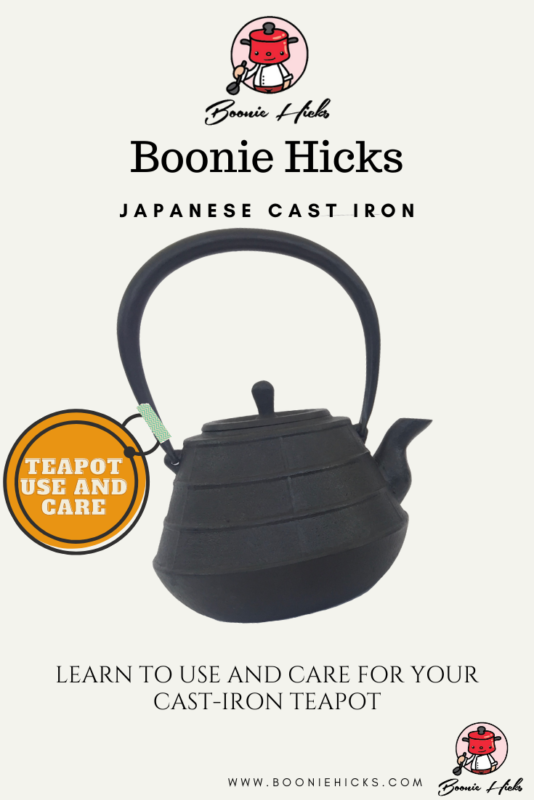
Why Do You Need A Japanese Cast Iron Teapot?
Japanese cast iron teapots come in various beautiful, traditional, and modern designs, such as cherry blossoms and dragonflies. Again, cast iron teapots are beautiful but durable and can last many years. With proper care, a cast iron teapot can be a heirloom you pass down through the generations.
Here Is A Brief History Of Cast Iron Tea Kettles And Teapots.
The use of cast iron kettles dates back to the early 17th century with an iron vessel called a Chadō. And if you go to a traditional tea ceremony in Japan, you will likely use a Chadō to boil water. These ceremonies are rooted in the Zen philosophy of harmony and inner peace.
Some ceremonies can last four hours and represent the utmost hospitality. Everything centers on the visual appearance and enjoyment of the tea. Furthermore, the aesthetics of these ceremonies are just as important as the tea.
To learn more about the origins of Japanese Cast iron or Nanbu Tekki, check out this article at Boonie Hicks.
On the other hand, Japanese teapots are a newer development and a way to enjoy your tea. Today, you can boil your water in a dual-purpose teapot that is quick to boil but brews in an easy-to-clean enameled teapot.
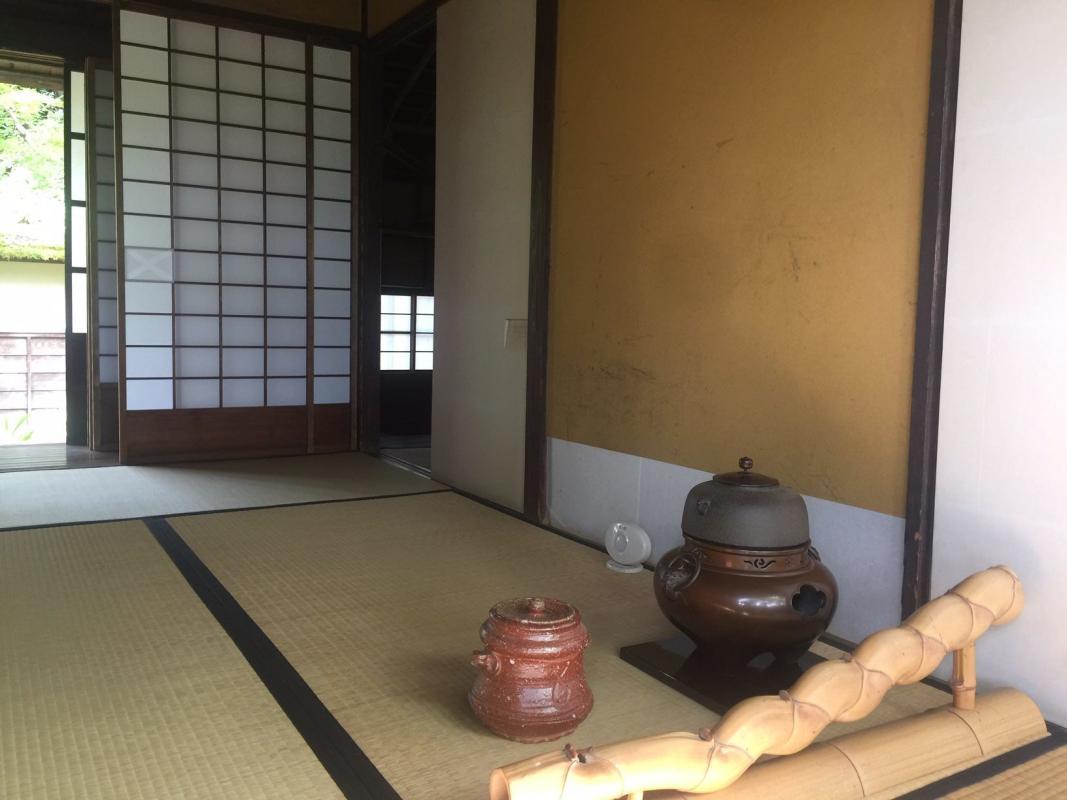
Benefits Of Cast Iron Teapots
Cast iron has experienced a resurgence in popularity because people are learning about the benefits cast iron offers. Cast iron is probably the only piece of kitchenware that improves over time, and cast-iron teapots are no different. Here are some of the benefits of cast iron teapots.
It Keeps Your Tea Hot.
Cast iron is heavy. But because of this, the material has good thermal density properties and retains heat well. Compared to glass, stainless steel, and ceramic teapots, cast iron tea kettles maintain their heat much longer. The material also evenly heats your tea, which helps with the brewing process.
Tea Tastes Better In Cast Iron.
Many tea experts use cast iron kettles and teapots to make the perfect cuppa. That is because they know that these vessels make for a better tea experience. There are several reasons which are:
- The enamel in cast-iron teapots is nonporous, which means teapots do not absorb flavors or smells that unglazed traditional ceramic teapots may do.
- Thermal density helps keep water at an even temperature. And it adds to the complexity and character of the tea.
Durable And Long-Lasting.
Cast iron teapots could potentially last forever if cared for properly. You may never need to buy another teapot ever. Cast iron only improves with time because it builds character over time. Cast iron teapots are virtually unbreakable and resistant to cracking and chipping. A good quality teapot is an heirloom that you could easily pass down through the generations.
Enameled Teapots Do Not Absorb Flavors.
As mentioned earlier, enameled teapots do not absorb smells. When you use your teapot, the only odor you want to smell is the tea. Cast iron enameled teapots do not absorb flavors or aromas from previous use. When finished, they are easy to wash, meaning your tea smells and tastes like freshly steeped tea.
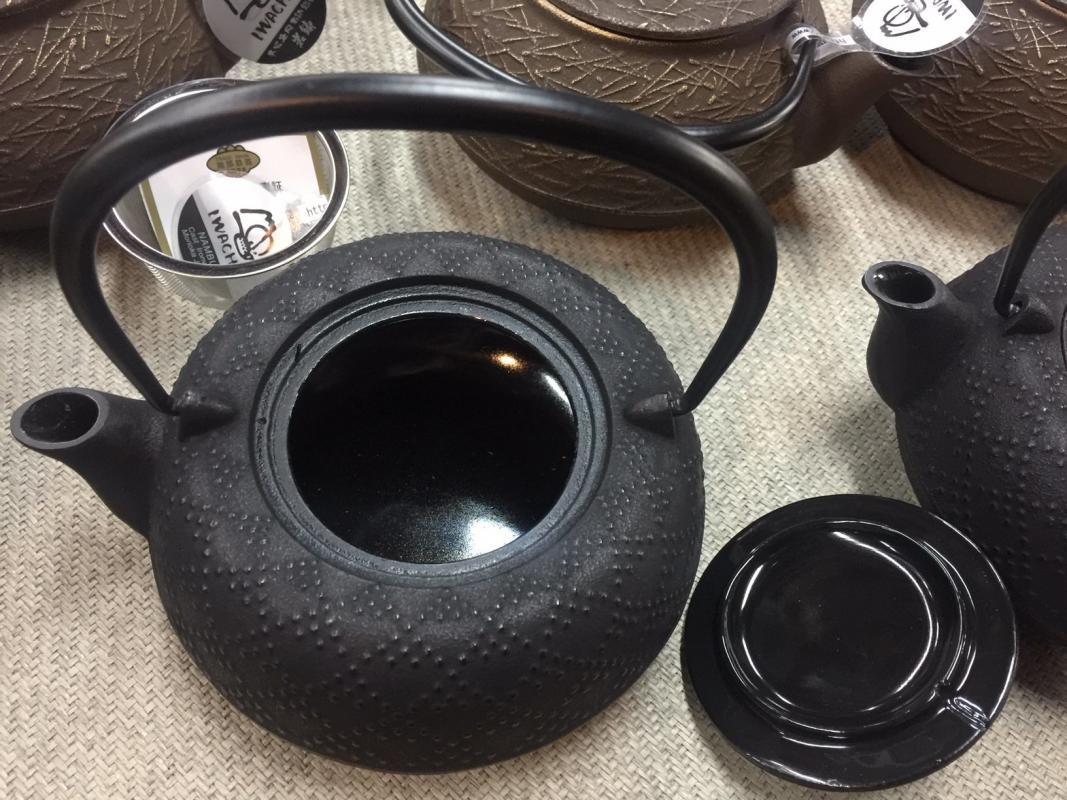
Classically Stylish And Beautiful.
Many cast iron teapots have beautiful traditional designs. These teapots are loved as much for their appearance as their practicality. They offer a stylish way to enjoy tea and make it feel like a special occasion. Also, cast iron teapots come in a variety of vibrant shades and colors to choose from.
Japanese teapots are called Tetsu Kyusu in Japanese. These traditionally styled teapots are lovely pieces to display on your kitchen shelf or bench. Teapots are great for get-togethers and special events, too. You can make great-tasting tea, and your guests will love your teapot.
Good Value.
A cast iron tea kettle is an excellent bargain for something that could last forever. You can get a top-of-the-line traditional cast-iron teapot from Zensuke for less than $100. If you want to know more about the benefits of cast iron, you may want to look at three other related articles on the site.
Getting The Most From Your Cast Iron Teapot
Now that you know the benefits of a cast iron teapot. How do you get the most out of yours? Here are some tips.
Know The Different Types Of Cast Iron Tea Kettles.
There are two types of Japanese cast iron tea vessels used to make tea.
- A tea kettle (Tetsubin)
- A cast iron teapot (Tetsu Kyusu)
Using the correct cast iron tea vessel for the right job would be best — because you could damage your teapot from incorrect use. Therefore, knowing which one you have is essential to get the most out of your cast iron tea kettle.
Tetsubin
Tetsubins, or traditional Japanese tea kettles, are used to boil water. These tea kettles are similar to antique Japanese water kettles. And also like the ones used in the Victorian era. They are entirely cast iron and feature a built-in swing handle. These tea kettles were heated directly over charcoal fires in many homes until the 20th century. You can use Tetsubins on gas stovetops and ceramic burners.
Click the link to find out why tetsubins are so expensive.
Tetsu Kyusu
Not to be confused with Tetsubins, cast iron teapots — or Tetsu Kyusu — have an enamel glaze on the inside. These are the modern versions of the classic Tetsubin. The enamel prevents rust, and the smaller size is more practical. Most Japanese teapots have an infuser, where you place loose tea leaves. Infusers serve the same role as tea bags and make cleanup easy.
Please do not use your teapots to boil water for tea. So, it would help to not use your teapot over an open or on the stovetop to prevent cracking.
You can learn more about the differences between the Japanese kettles and teapots with this article.
Learn How To Brew Tea Correctly.
To keep your cast iron teapot in good shape, use and care for it correctly. Here are some tips to ensure a lifetime of use.
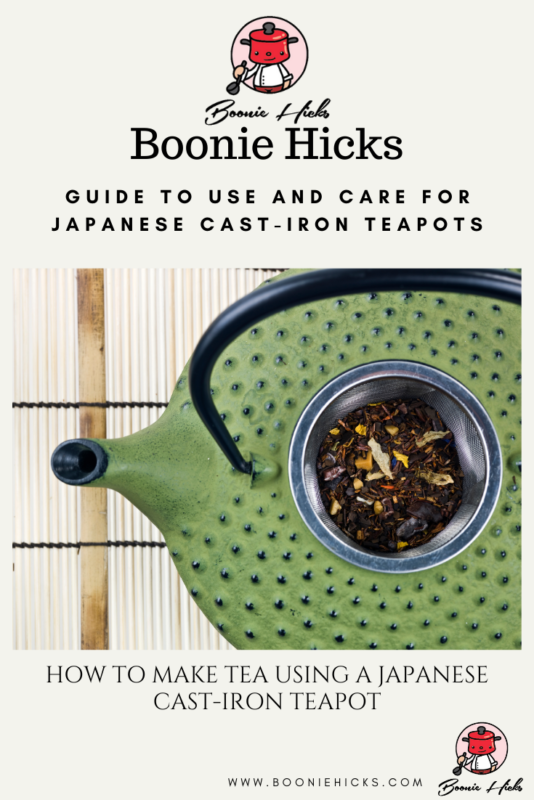
How To Brew Tea In Your Cast Iron Teapot In 6 Easy Steps
| Boil Water | First, boil the water. Ideally, you should use a Japanese kettle to boil water. If you do not have a tetsubin, then boil water in a pan or kettle. I would avoid plastic-lined kettles if you can. These kettles can negatively change the taste of the water. |
| Heat Your Teapot | Next, preheat your teapot. Pour warm water into your teapot, let it sit for two minutes, and discard the water. |
| Add Loose Tea Leaves | Then place loose tea leaves into the infuser of your cast iron teapot. I use the old-fashioned method of one teaspoon per cup as a general rule. If your budget allows, try a traditional Japanese Sencha loose-leaf tea. However, if you are new to tea drinking, then a sampler pack from Tea Forte Tea Forte offers a variety of teas from around the world. But my favorite is tea Lady Grey from Twinings. Links take you to Amazon if you are interested. Only fill the infuser about halfway as the leaves will expand. This will allow for more efficient brewing. |
| Add Water | After the water boils, add enough to the cast iron teapot to submerge the tea leaves. I recommend using approximately 200ml of water per one teaspoon of tea leaves. |
| Steep | Next, place the lid on the teapot and allow enough time for the tea to steep. For steep times, check out the instructions that came with the tea that you are using. Let the water cool a bit first if you are using green tea. It tastes best when brewed at lower temperatures. Green tea also requires shorter brew times. Try not to steep green tea for longer than 3 minutes. Black tea requires longer steep times and higher temperatures. |
| Pour And Enjoy | Lastly, to prevent the tea from becoming bitter or acidic. Immediately pour it from the teapot or remove the infuser and enjoy. |
How To Take Care Of A Cast Iron Teapot
To keep your cast iron teapot in good shape, you should use and care for it the right way. Here are some tips to ensure a lifetime of use.
First Use
Before using your cast iron teapot for the first time, rinse the pot with boiling water and then dry thoroughly.
After Each Use
After each use, make sure you do the following:
- Allow the teapot to cool before drying.
- Next, rinse the pot out with warm water.
- Try not to use harsh soaps or detergents.
- While the teapot is still warm, wipe the outside with a clean, dry cloth.
- Turn the teapot upside down and let it air dry with the lid off.
General Care Tips
Here are some general care tips:
- Polish the surface of your cast iron teapot with a tea-soaked cloth. Doing this will help prevent rust, and it will also keep it looking glossy.
- Remember, if your cast iron teapot has an enamel lining inside, Never use it to boil water. Otherwise, you might crack the enamel.
- Hot iron could stain countertops and other surfaces. So, always place your teapot on top of a trivet.
- You might notice water marks or spots on the bottom of your teapot after a couple of weeks of use. A buildup of minerals causes these spots.
Don’ts:
Here Are Some Things That You Should Not Do When It Comes To Your Cast Iron Teapot.
- Use harsh chemicals to try to remove rust. These cleaners are toxic and can damage the metal.
- Above all, do not put a cast iron tea kettle in the dishwasher.
- Pour cold water into a hot cast iron tea kettle. Pronounced changes in temperature can cause stress fractures due to the iron expanding and contracting.
- Place a cast iron teapot over an open flame or use it on the stovetop. It could crack the enamel.
- Allow your cast iron teapot to come into contact with salts or oils.
How To Restore A Vintage Cast Iron Teapot
If cared for properly, cast iron kitchenware will last forever. Both cast iron tetsubins and vintage enameled cast iron teapots that are damaged can rust if exposed to water for a while. If you leave standing water in a cast iron teapot, the next time you go to use the teapot, you might notice some rust.
Are you wondering if your teapot is safe even if it has rust? There is no need to go out and buy a new cast iron tea kettle just because it has a layer or two of rust flaking off. It is perfectly safe to still the kettle. Interestingly, some tea connoisseurs like to drink tea from a pot with rust. As they believe rust can enhance the taste of the water.
However, if you’d like to restore your vintage cast iron teapot to its former glory, you can do so — even if it has a pretty thick layer of rust. With a little TLC, your teapot will look brand new. Here are detailed instructions for restoring your tea kettle.
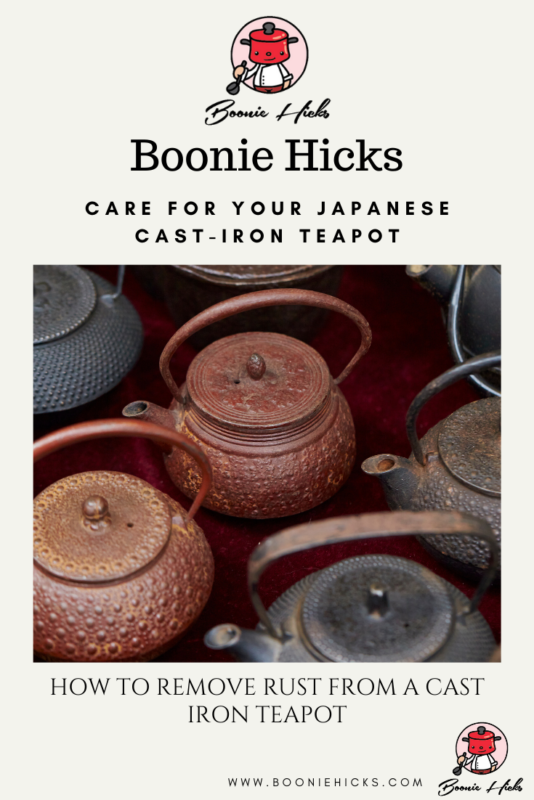
Remove Rust From Your Vintage Teapot In Five Easy Steps.
Remove Surface Rust | Firstly, use a small wire brush and lightly spot-brush the rust by hand. You can also use a Brillo, SOS, or another abrasive scouring pad. However, brush gently to prevent scratching, especially on the enamel. |
Add Tea | Next, fill the pot with used green or black tea leaves. Make an extra-strong brew of tea. |
Add Boiling Water | Add boiling water which releases tannins from the leaves. |
Steep | Then, allow the brew to sit and cool for at least 20 minutes. The tannic acid will react with the rust and form a natural seal. This helps to prevent rust from coming back. |
Discard Tea | Finally, discard the tea and rinse and make sure the teapot is completely dry. |
What If The Above Doesn’t Work?
If you have heavy iron deposits on your cast iron teapot, then you might try these tips:
- Try a 50/50 solution of white vinegar and water. Let the solution sit for a couple of hours so the mixture can work.
- If the vinegar solution does not work. You can also try scrubbing the tea kettle with a paste of baking soda and water.
Final Thoughts
A cast iron teapot is a fun and durable kitchen tool that can last for ages with the proper care. But most importantly, choose your favorite flavor of tea and get brewing. And enjoy your teapot.
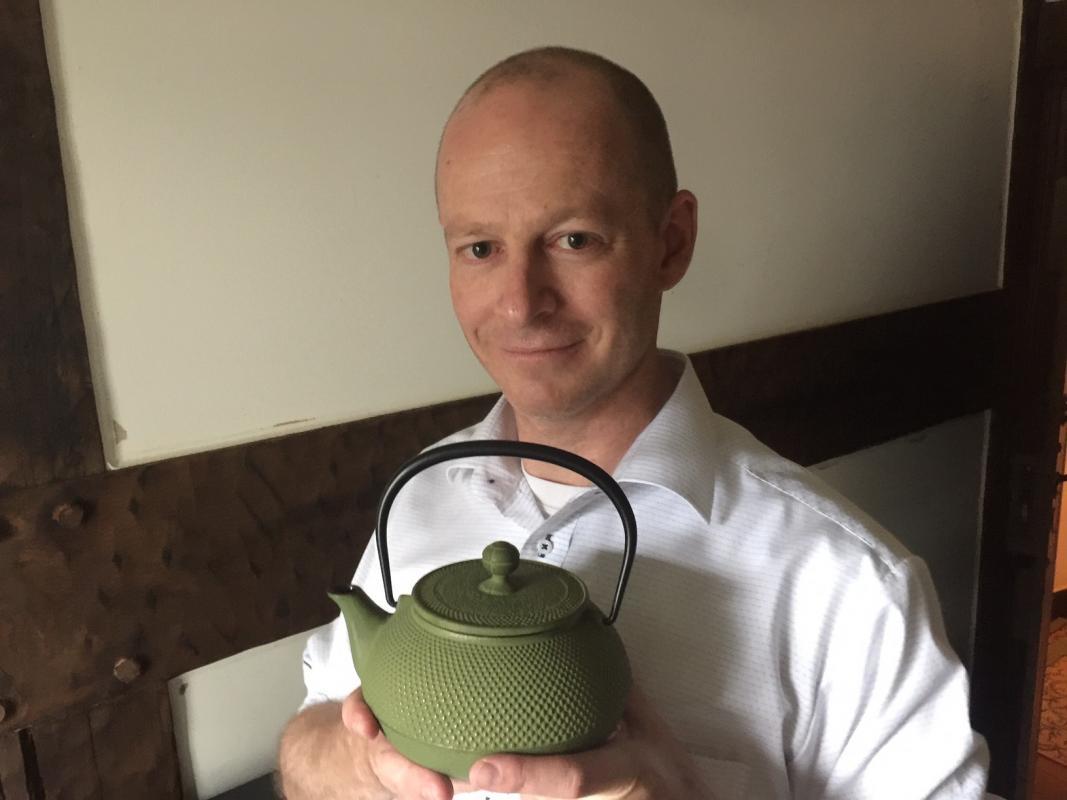
References:
- Japanese tea ceremony (Wikipedia)
- Japanese teapots explained (CALIFORNIA TEA HOUSE)
- Nanbu tekki (Google arts and Culture)
- Is rusty water and is it safe? (Berkeley Wellness)

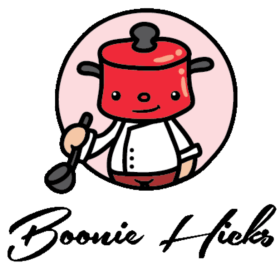
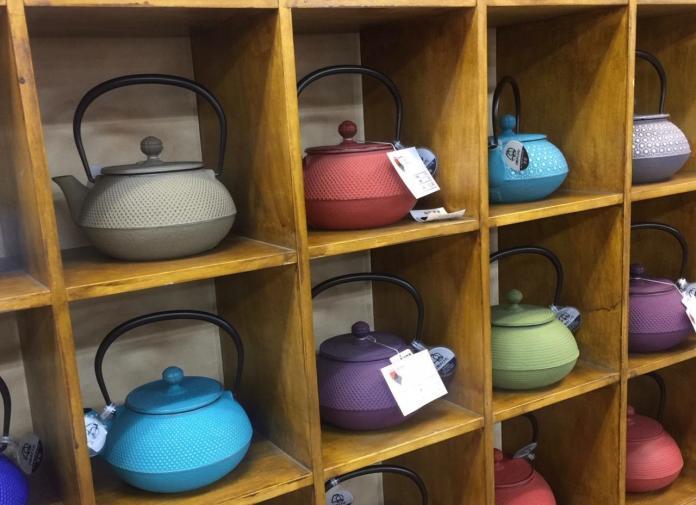
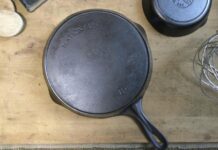
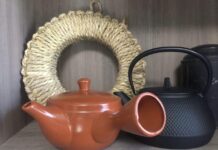
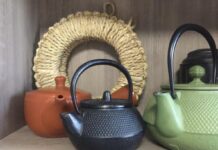



What happens if you allow cooking oil to come in contact with the inside of your Tetsu Kyusu? I am curious because all other cast iron items, such as pots and pans, require oiling to prevent rust.
I bought a used Tetsu Kyusu with a bit of rust on the inside of the lid and the bottom of the teapot. I used a boiling 2.5% vinegar solution to soak the rust, then scrubbed it. Then, I used a tiny oil drop to rub inside the lid only. I did not oil the inside of the teapot as I did not want my tea to taste like oil 😅
Would you please make any suggestions for me? Did I ruin the teapot by scrubbing and the oiling? What is the worst that can happen?
Hi Nata
It sounds like you are familiar with using and seasoning cast iron. And good on you for restoring a used teapot. I am sure many people would not have the experience or confidence to return their teapot to its former glory.
You certainly have not ruined your teapot, and I suspect many tea drinkers use an oily sponge to wash their teapot all the time. I even have one Japanese teapot factory seasoned with oil like a skillet. So keep on using it, and I hope you enjoy your teapot.
I often drink hot lemon water and wondered if I can put hot water in my cast iron teapot and then just steep the lemon in the pot? Will this harm the lining? I have recently come across two teapots and bought them both but haven’t tried hot lemon water in them yet.
Hi Carl
Adding a little lemon juice shouldn’t damage the nonporous enamel. However, the acidity in the lemon is likely to lift tannin buildup that might flake off into your tea. Adding a little lemon is a simple way the keep the enamel lining clean.
If you have a seasoned teapot without an enamel lining, please avoid adding lemon. And, add sugar once you’ve poured your tea into a cup to make cleaning your teapot easier.
Hope this helps
Cast iron teapots can come with or without enamel coating, I intentionally tried to find one without enamel so that I would get the traditional experience as well as the trace amounts of iron to prevent anemia. But my teapot arrived and seems to be painted on the inside… is there a third option. enamel coated, uncoated and… something else?
Hi Carl
Thanks for getting in touch.
You’re spot-on, there’s a third option. Some modern teapots are coated with seasoning, similar to a cast-iron skillet. These teapots are dual purposed so you can boil water and steep your tea in the same pot. But please check the user instructions first to be on the safe side.
I also see these teapots used in Japan and the design came about by younger people not knowing how to look after a traditional tetsubin. Or not wanting the maintenance fuss that comes with looking after a raw iron kettle.
Although more iron will leach from a raw iron kettle, a seasoned teapot like yours should release a little iron into the water as well.
Congratulations on your purchase, I hope you enjoy your teapot.
I’m curious…I love my teapot and I love making tea with it…but I also love putting honey in it sometimes. Am I allowed to put other additives like honey or lemon in these pots or the cups they come with?
Hi Michelle
Thanks for getting in touch.
If you use different teas or add different flavorings in your teapot, I’d recommend to thoroughly rinse your teapot after use.
However, lemon won’t damage your cast iron teapot or cups. Your teapot is likely to have an enamel lining. And enamel is nonreactive to the acidity in the lemon.
Undissolved honey wont damage your teapot either but it could make cleaning difficult. I’d stir in lemon and honey in your cups. It will make cleaning up a lot easier.
Honey and lemon, wow, sounds great.